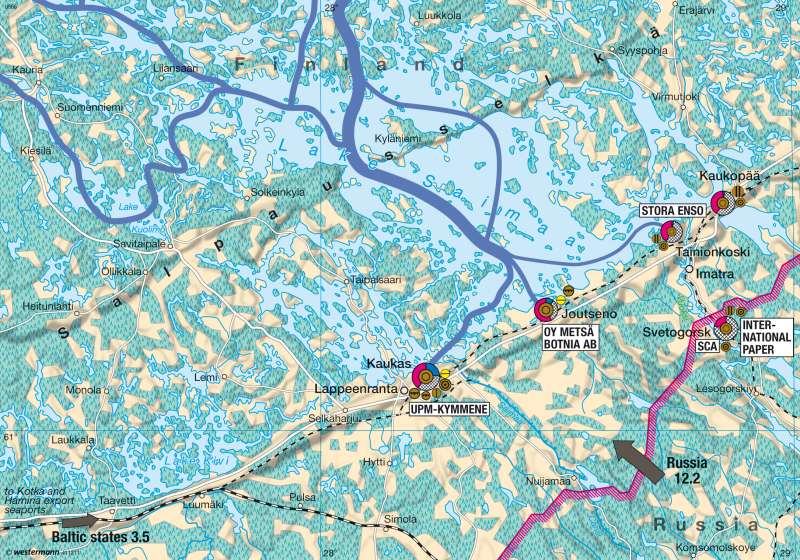Lake Saimaa (Finland) — Production sites of the wood industry
Northern Europe - Resources
978-3-14-100790-9 | Page 63 | Ill. 3

Information
The wood processing industry on the southern edge of the Finnish Lake District manufactures under ideal conditions: relatively short and low-cost routes for the transport of the necessary timber from large forests in the close vicinity, the import of timber also from the Baltic States and Russia, the multistage processing of timber in integrated operating facilities, and short routes to the ports for export.The wood processing industry is divided into a chemical and a mechanical branch. The chemical branch comprises the successive processing stages of pulp mill — chemical pulp factory — paper and board factory, often in integrated plants. The mechanical branch comprises industrial sawmills and plywood factories, and sometimes also chipboard and fibreboard factories.
About 60 percent of the timber processed in the factories shown on the map is obtained from private forests in the region, supplemented by imports from Russia and the Baltic. Company-owned forests are only of significance in the districts of Lappenranta and Imatra. The proportion of coniferous wood (mainly pine) is between 40 and 100 percent, the rest consisting of birch which is mainly grown in Kaukopää. The following rule of thumb can be applied to convert the volume of timber to the resulting quantity of pulp production: 2 million cubic metres of timber generates 330,000 to 400,000 tons of pulp or paper.
The Finnish Forest Products Industry
The Finnish forest products industry is characterized by a small number of large concerns (on the map: Stora Enso, Oy Metsä Botnia AB and UPM-Kymmene) which, following a process of restructuring, have also been active for some years as global players on the international wood markets. In Finland in 2007, some 14.3 million tons of paper and board were manufactured (+1 percent against 2006; Germany in 2007: 23.2 million tons), 90 percent of which was exported. The world market for paper is currently growing strongly (consumption in 2007: 370 million tons), especially in Asia, but production there is also growing so that Asian paper companies are increasingly penetrating European markets. The resulting situation of increased competition has led to the closing of unprofitable paper mills and a slight reduction in production capacities. The Finnish paper companies have also internationalized their production and sales; they operate e.g. production facilities in Asia and America.
In 2007 the firms belonging to the forestry industry had sales of 22.5 billion euros, 38 % of which consisted of paper and board. In Finland itself, some 62,000 people were employed in the forestry industry in 2006, half of these in the paper industry.
In addition to paper, pulp (2007: 13 million tons, export share 19 percent), sawn wood (2007: 12.4 million cubic metres, export share 58 percent) and plywood (2007: 1.4 million cubic metres, export share 87 percent) are manufactured. In order to ensure competitiveness, as well as the internationalization of production and sales, the emphasis is also placed on the development of new products, modern and efficient production processes and the sustainable use of natural resources (among other things through certification, reduction of emissions and water protection projects).
R. Löttgers; Ü: J. Attfield




